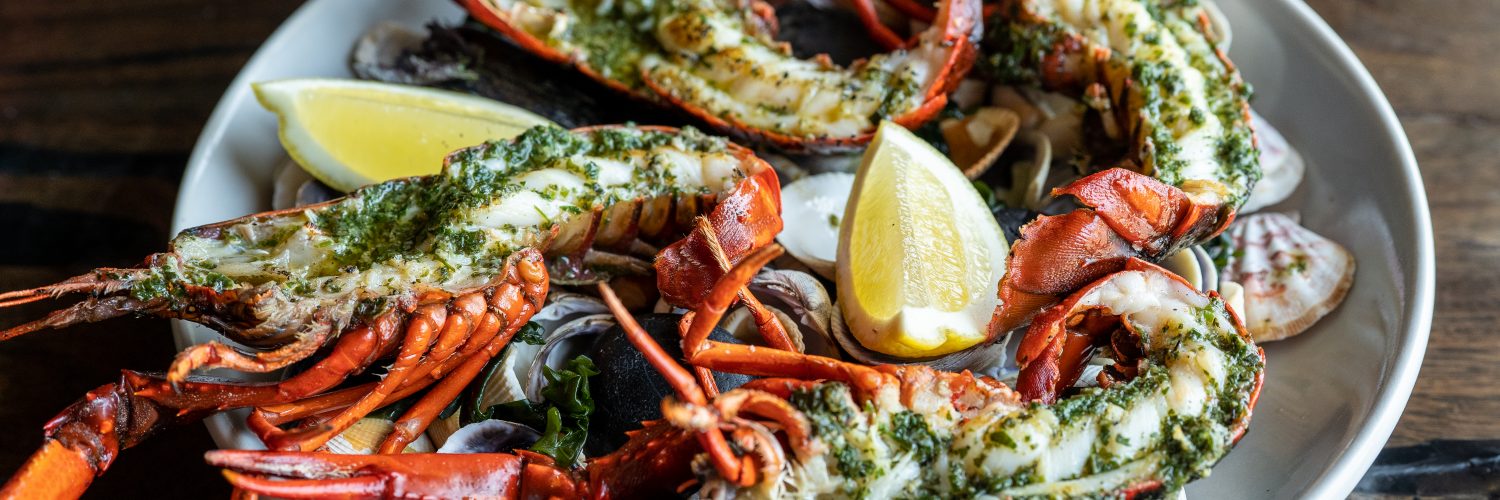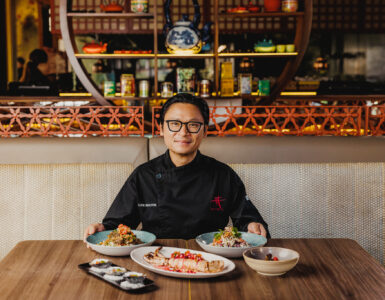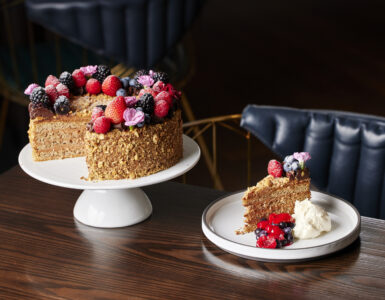Lobster mornay? Grilled butter lobster? Lobster pasta? Our Chefs debate the best way to cook the most covetable of crustaceans.
Lobster: you don’t eat it casually. Or if you do, you should consider yourself lucky. But this creature – with its subtle flavour, delicate texture and luxury price tag – deserves to be treated well. Especially considering the ease with which lobster can tip from melt-in-your-mouth buttery to jaw-achingly rubbery.
Its also an easy flavour to overpower, which is why debate rages on – or at least in Chef world – about the best way to cook it. Do you eat it fresh or slather it in butter? Cover it in mornay or flake it up to swirl through pasta? Our Chefs have their own ideas about how to cook lobster. We picked their brains for quality lobster-cooking tips and convinced them to share some of their favourite lobster recipes.
Let’s start at the beginning: what are your tips for choosing a lobster?
Steven Jones (Executive Chef, Treasury Brisbane): Always buy it fresh rather than frozen. It’s about the integrity of the flesh. Although frozen lobster can be good, especially when it has been recently frozen or snap-frozen. Look for lobsters in the size range of between one to two kilograms. This means they have plenty of meat and are usually very sweet. Larger sizes of lobster go very fibrous and are texturally unpleasant to eat (i.e. too firm).
Dayan Hartill-Law (Chef de Cuisine, Cucino Vivo): This is 100% dependant on your budget. If you have the ability to buy Tasmanian crays then always do! They are the best; pure luxury when it comes to the world of lobster. We serve them all over the property and often will have high rollers request them live and cooked on our massive wood grill. But there are so many variants on lobster. We use a Champagne lobster in Cucina Vivo at the moment, which is a little more wallet-friendly. They are super delicious and are caught in Queensland waters. Then there is the huge influx of Canadian lobsters, which you would be seeing in Coles and Woolworths. These aren’t awful so long as you drown them in butter.
Mitchell Tucker (Chef, Nineteen at The Star): Fresh, live Southern Rock lobsters are a must. I prefer them to be between the 1–1.5kg mark as I find the flesh to be at its sweetest.
What’s your favourite simple way to cook a lobster?
SJ: Split the lobster in half, remove the fat from the head area, remove the tube from the tail, then grill it over a wood-burning stove with garlic, soft herbs (basil and chervil), and a little garlic butter.
DHL: For me, nothing can beat a lobster roll. A load of garlic butter or aioli, celery leaf and buttery, toasted brioche with ultra-fresh lobster: this is what living is all about. Poach the lobster in the butter until it is sweet and crunchy and garlicky and rich. If you’re feeling a little baller, throw some caviar on top and down it with some Dom Pérignon.
MTl: My favourite way to cook lobster is mornay. This is just one of the ways we prepare lobsters for our guests here at Nineteen at The Star. It’s simple yet delicious, and very relatable to our guests.
How about your favourite “fancy” way to cook a lobster?
SJ: Lobster Thermidor is cooked from a live tank. The lobster is taken carefully out of the shell and presented on a large platter with the trimmed shell of the head and the bottom of the tail fanned out. The meat is pulled out and cut into bite-sized medallions, coated in a hollandaise (lightly whipped cream, egg yolk, parmesan cheese, tarragon and a little cognac) and then glazed under the grill.
DHL: Actually, the coolest thing I have ever done with a cray was at Quay in Sydney. We did a dish that was five textures of lobster, using Tasmanian crays that were brought to us by the farmer who had dived for them himself. It was a great privilege to use these crays and we did them justice, I believe. Every gram was used and treasured for the deliciousness that it offered to us. It was such a luxurious dish; I have never tried anything like it, nor seen a more respectful preparation of a cray.
MT: The lobster itself is the fancy part. I don’t have a fancy way of cooking them; I just like to showcase the beautiful taste of the lobster itself without having to overwork things.
What should you not do to a lobster?
SJ: Don’t overcook it. Treat it with respect, as it’s a premium ingredient.
DHL: Lobster is actually a pretty difficult thing for an amateur to cook. If you’re not confident then I advise against it, because the absolute worst thing you can do is take the beautiful creature from the water and overcook it. It will be crappy for you and it’s a complete dishonour to the product.
MT: Please never overcook a lobster! You will end up with a rather expensive, rubbery nightmare.
Could you share your favourite lobster recipe?
DHL: Lobster, when I cook it, isn’t really recipe-based. It’s done more by feeling – as you prepare it, as you cook it, and ultimately when you eat it. My goal is always to find a balance between hits of butter and lemon throughout the cooking process. Utilise the shell, if you are taking out the flesh, and even use the coral. I truly believe lobster is something that is best left to the professionals, as there is a feeling that comes with it.
MT: Sure! The lobster mornay recipe.
Ingredients:
- 45g plain flour
- 45g soft butter
- 500mL milk
- 2g nutmeg
- 150mL white wine
- 40mL sherry
- 1 shallot
- 3 cloves
- 3 bay leaves
- 1g white pepper
- 5g salt
- 40g confit garlic
- 15g hot English mustard
- 40g grated fontina
- 2 egg yolks
Method:
Bring milk to heat with nutmeg. Cook out the flour and butter, making a blonde roux. Whisk in hot milk and cook out for 30 minutes. Reduce wines (white wine and sherry), shallot, bay leaves and clove by ¾. Strain the reduction and add to the roux. Add the mustard, confit garlic and fontina. Season with salt and white pepper. Finish with egg yolks.














